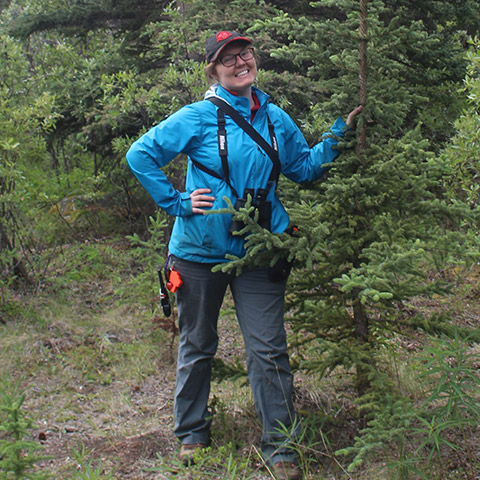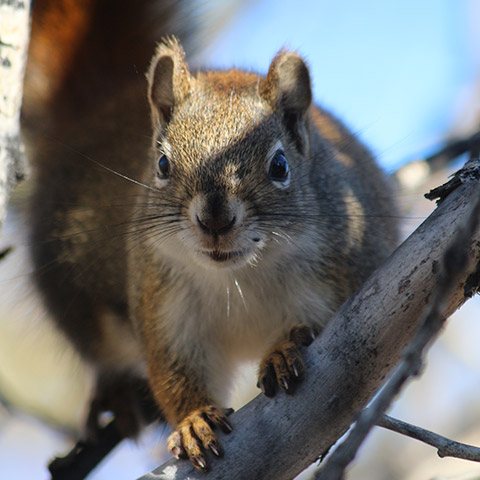The science of squirrels
The first time Andrea Wishart held a baby squirrel, she knew then she wanted to better understand the furry little creatures, especially their boom-or-bust behaviours.
By Chris MorinThere are plenty of reasons why these bushy-tailed critters would want to maximize the amount of food to store for the winter, especially in the harsh climates of the Yukon, where Wishart, a PhD student at the University of Saskatchewan, conducts her research.
So why do some squirrels, who are active all year-round, hustle hard when it comes to gathering their food while others seem to slack?

“Squirrels are famous for caching food, storing it in their body as fat, or they will cache it in stores,” said Wishart. “So when they are breeding they return to this food source rather than seeking out additional sources. In the case of red squirrels, they have essentially collected a ‘refrigerator’ full of food underground.
“Obviously, there are really important survival reasons for them to collect this food,” she continued. “But we see a huge variation in the amounts of food that these squirrels are collecting. Some squirrels have nothing, while others have a lot. So why aren’t all of them going crazy caching as much as they can?”
There are plenty of mitigating factors for squirrel survival, and that’s what Wishart aims to find out. Now in her third-year in the Department of Biology, Wishart tracks and observes the mischievous critters at the Kluane Red Squirrel Project, a small research camp that overlooks the Saint Elias mountains in the Yukon. It’s where U of S students like Wishart go to study ecology and evolution. It also provides plenty of opportunity to observe wildlife in an environment that you wouldn’t necessarily see elsewhere, said Wishart.
“Squirrels are very territorial creatures, and we are able to track pregnancies in these animals, and we often get to see squirrel babies the day they are born. And from there we are able to track their successes, their behaviours and their interactions.”
The Kluane Squirrel Project, an interdisciplinary, large-scale field experiment, started in 1987 as a partnership between the U of S and four other universities: Alberta, Guelph, McGill and Michigan. Since then hundreds of researchers have flocked to the site, which helps provide invaluable historical evolutionary data for squirrel scientists, said Wishart.
“The boreal forest in this region is made up of white spruce, which is what these squirrels depend on for food," she said. "And these trees will sometimes produce a huge amount of pinecones, an incident which is called a pulse. This overabundance of food allows for new trees to be seeded within the resource system.
“While red squirrels are found throughout the country, including areas around Saskatoon, the unique environment offers an intimate glimpse into their world.”

Originally from London, Ont., where she finished both her undergrad and her master's, Wishart delved into the world of genomics and mutations in mice before deciding to take a break from her studies to volunteer with a wildlife rehabilitation group. That’s when she found her calling.
“On my first day, I was handed a baby eastern grey squirrel and a syringe full of formula,” said Wishart. “I was told then and there that I was going to learn how to feed these animals. Obviously, they are really cute, but it was taking time away from research that made me realize how I wanted to get back to asking questions about ecology and evolution that I was studying in my undergrad.”
And when it came time to return to her research, Wishart said while the U of S was the ideal school to study food management with squirrels, she was ecstatic to find herself in one of the furthest corners of the country, tracking these mammals.
In addition to providing the perfect place for her rodent research, the Yukon-based camp also provides an endless swath of breathtaking scenery—a backdrop that Wishart says is “ridiculously beautiful” for practicing her budding photography skills.
“The moments I’ve been able to capture animals interacting are some of the most memorable moments I’ve had there,” said Wishart. “When it comes to squirrels I tend to miss out on a lot of those moments since I’m usually in the middle of doing research, and I’ll curse not having a camera ready.
“That said, I’ve been fortunate enough to capture some really great squirrel shots.”

